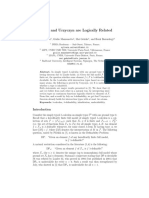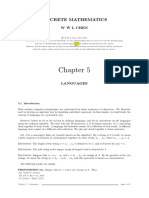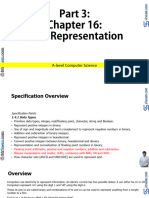My-Hill Nerode Theorem
My-Hill Nerode Theorem
Uploaded by
maddhuri_anushaCopyright:
Available Formats
My-Hill Nerode Theorem
My-Hill Nerode Theorem
Uploaded by
maddhuri_anushaCopyright
Available Formats
Share this document
Did you find this document useful?
Is this content inappropriate?
Copyright:
Available Formats
My-Hill Nerode Theorem
My-Hill Nerode Theorem
Uploaded by
maddhuri_anushaCopyright:
Available Formats
CS 172: Computability and Complexity
Fall 2003 c Tom Henzinger
Lecture 7: Myhill-Nerode Theorem
7.1 Word equivalence. Consider a language L over an alphabet . Two words x, y are L-equivalent, written x L y, i for all words z , we have xz L i yz L. For example, if = {0, 1} and A = 0, then A has four equivalence classes: A1 A2 A3 A4 = 00 = 01 = 10 0 = 11 1
If = {0, 1} and B = {0n 1n : n 0}, then B has innitely many equivalence classes: B = {0n 1m : m > n 0} 1 0 B0 = {0n 1n : n 0} B1 = {0n 1n1 : n 1} B2 = {0n 1n2 : n 2} B3 = {0n 1n3 : n 3} . . . The number of equivalence classes of L is called the index of the language L. In particular, the index of A is 4, and the index of B is . 7.2 Word equivalence is a right congruence. The equivalence L has the following two properties: (1) If x L y and x L, then y L. (2) If x L y, then xa L ya. They are immedite consequences of the denition. 7.2 Myhill-Nerode theorem, part 1. The equivalence relation L characterizes exactly what the state of an automaton that denes L needs to remember about the read portion of the input: if the read portion of the input is x, then the state needs to remember the equivalence class [x] L . This is sucient, because if x L y, then it does not matter if the read portion of the input was x or y; all that matters for deciding whether to accept or reject is the future portion of the input, say z, because xz L i yz L. It is also necessary, because if x L y, then there is some possibe future portion z of the input such that xz needs to be accepted and yz rejected (or vice versa). This is formalized by the following two theorems. Theorem 7A. If the index of a language A is k, then there is a k-state DFA MA such that L(MA ) = A. To see this, let A be a language with index k. (Q, , , q0 , F ), whose states the A -equivalence classes: Dene the following nite automaton MA =
Q = {[x]A : x }. q (p, a) i there exists a word x p such that xa q. q0 = []A . q F i there exists a word x q such that x A. From (2) it follows that MA is deterministic. From (1) it follows that for all states q Q, either q A = or q A. Therefore, for every word x , after reading input x, the DFA MA ends up in the state [x]A , which accepts if x A and rejects if x A. For A = 0:
1 A1 A2
A3
A4
It can be shown that for every DFA D, the quotient automaton D/ is equal (up to renaming of states) to the DFA ML(D) . 7.3 Myhill-Nerode theorem, part 2. In the previous section we saw that every language with nite index is regular; now we will see that every regular language has a nite index. Theorem 7B. For every k-state DFA M , the index of L(M ) is at most k. To see this, consider a DFA M over the alphabet . For two words x, y , let x M y i after reading input x, the DFA M ends up in the same state as after reading input y. The number of M -equivalence classes is equal to the number of states of M , say k. If x M y, then x L(M ) y, because inputs xz and yz always lead to the same state. Hence there can be no more L(M ) -equivalence classes than there are M -equivalence classes; that is, the index of L(M ) is at most k. Theorem 7B can be used to show that a language is nonregular: it suces to argue that its index is . Theorem 7B can be strengthened to show that if M is reduced (i.e., M = M/ ), then the index of L(M ) is exactly k. From that and Section 7.1 it follows that for every regular language L there is a unique (up to renaming of states) minimal DFA (with the fewest number of states), and that this DFA can be obtained by applying the quotient construction to any DFA for L. 7.4 Nondeterminism and minimality. There may not be a unique minimal NFA for a regular language. For example, the following three automata all dene the same language, namely 0, and are all reduced:
0,1
0,1
0,1
0,1
7.5 Bisimilarity. For DFAs, if two states p and q are equivalent, then for all input letters a, also (p, a) and (q, a) are equivalent. By contrast, for NFAs, two states p and q may be equivalent even though there are no equivalent states in (p, a) and (q, a). For instance, for the following NFA N , states A and B are equivalent even though no two of C, D, and E are equivalent:
0,1
L(NA ) = L(NB ) = L(NG ) = {00, 01} L(NC ) = {0} L(ND ) = {1} L(NE ) = {0, 1} L(NF ) = {} For NFAs we can dene a stronger concept than state equivalence called state bisimilarity, which corresponds to recursive state equivalence: two states p and q of an NFA M = (Q, , , q0 , F ) are bisimilar, written p B q, i the following three conditions are satised: M (1) p M q (this can be weakened to p 0 q). M (2) For all a and all p (p, a), there exists a state q (q, a) such that p B q . M (3) For all a and all q (q, a), there exists a state p (p, a) such that p B q . M For the example automaton N , we have
A
B N
but
B G. N
7.6 Minimization of nondeterministic automata. When applied to NFAs, the minimization algorithm (suitably adjusted) computes state bisimilarity, not state equivalence. Recall the NFA N from Section 7.5:
A B C D E F G
2 1 1 1 0 2
A
1 1 1 0
B
1 1 0 1
C
1 0 1
D
0 1
E
0
F G
You might also like
- HW2 Solutions 2017 SpringDocument10 pagesHW2 Solutions 2017 Springstephengogo1991No ratings yet
- DFA Minimisation Using The Myhill-Nerode TheoremDocument10 pagesDFA Minimisation Using The Myhill-Nerode TheoremTomás HernándezNo ratings yet
- Myhill-Nerode Theorem: able by A iff for every string z ∈ ΣDocument2 pagesMyhill-Nerode Theorem: able by A iff for every string z ∈ ΣKushal KanungoNo ratings yet
- Hw2sol PDFDocument7 pagesHw2sol PDFSaa-dia BatoolNo ratings yet
- Tut-1 Solutions MergedDocument12 pagesTut-1 Solutions MergedChirag ahjdasNo ratings yet
- Myhill Nerode TheoremDocument28 pagesMyhill Nerode TheoremMehak AggarwalNo ratings yet
- Some Pumping Lemmas: Conrad T. Miller Math 5358 April 30, 2007Document9 pagesSome Pumping Lemmas: Conrad T. Miller Math 5358 April 30, 2007Shivam BansalNo ratings yet
- Theorist's Toolkit Lecture 2-3: LP DualityDocument9 pagesTheorist's Toolkit Lecture 2-3: LP DualityJeremyKunNo ratings yet
- Formal LanguagesDocument47 pagesFormal LanguagesSourav RoyNo ratings yet
- BGMSDocument12 pagesBGMSrifowoj918No ratings yet
- Chapter 3 Regular ExpressionDocument25 pagesChapter 3 Regular ExpressionmimisbhatuNo ratings yet
- Discrete Math Lectures NotesDocument172 pagesDiscrete Math Lectures NotesAriel MorgensternNo ratings yet
- Designing Context-Free GrammarsDocument5 pagesDesigning Context-Free Grammarsraushan_ratneshNo ratings yet
- Pset2 SolutionsDocument5 pagesPset2 Solutionsaniketgupta3001No ratings yet
- A New Type of Generalized Difference Sequence Spaces of Fuzzy Numbers Defined by Modulas FunctionDocument10 pagesA New Type of Generalized Difference Sequence Spaces of Fuzzy Numbers Defined by Modulas FunctioninventionjournalsNo ratings yet
- Enumeration of Automata, Languages, and Regular ExpressionsDocument63 pagesEnumeration of Automata, Languages, and Regular ExpressionsGuru MahaNo ratings yet
- Entropy 5Document9 pagesEntropy 5concoursmaths2021No ratings yet
- Bai 1.57Document5 pagesBai 1.57Ninh HàNo ratings yet
- Test 2 SolutionsDocument3 pagesTest 2 SolutionsPhillip DoNo ratings yet
- Lecture 15: Computing With Turing MachinesDocument13 pagesLecture 15: Computing With Turing Machineswenqiang0716No ratings yet
- CS 717: EndsemDocument5 pagesCS 717: EndsemGanesh RamakrishnanNo ratings yet
- AT&CD Unit 1Document19 pagesAT&CD Unit 1nothingnewtonnew10No ratings yet
- Tut 1Document2 pagesTut 1am azonNo ratings yet
- Ring Homomorphisms: DefinitionDocument4 pagesRing Homomorphisms: DefinitionTom DavisNo ratings yet
- TTE Computability On Moschovakis Extensions: Dimiter SkordevDocument22 pagesTTE Computability On Moschovakis Extensions: Dimiter SkordevdskordevNo ratings yet
- Notes On Absolutely Continuous Functions of Several VariablesDocument16 pagesNotes On Absolutely Continuous Functions of Several VariablesSufyanNo ratings yet
- Discussion: Context-Free Grammars: Questions On Homework or Exam?Document5 pagesDiscussion: Context-Free Grammars: Questions On Homework or Exam?bijan11No ratings yet
- Notes On The Myhill-Nerode TheoremDocument2 pagesNotes On The Myhill-Nerode TheoremSamar HamadyNo ratings yet
- Solutions To The 69th William Lowell Putnam Mathematical Competition Saturday, December 6, 2008Document7 pagesSolutions To The 69th William Lowell Putnam Mathematical Competition Saturday, December 6, 2008Ganesh KumarNo ratings yet
- COL352 hw2Document5 pagesCOL352 hw2pratik pranavNo ratings yet
- Automata Theory Problems and ExercisesDocument11 pagesAutomata Theory Problems and ExercisesKate Bayona50% (2)
- Open Problems in Automata Theory and Formal LanguagesDocument50 pagesOpen Problems in Automata Theory and Formal LanguagesPro NebyuNo ratings yet
- NST Mmii Chapter2Document27 pagesNST Mmii Chapter2drfaizalNo ratings yet
- The Complex Inversion Formula Revisited: Markus HaaseDocument11 pagesThe Complex Inversion Formula Revisited: Markus HaaseajeelahNo ratings yet
- Asymtotic BehaiorDocument169 pagesAsymtotic BehaiorLuis ValerinNo ratings yet
- COL352 hw1Document4 pagesCOL352 hw1pratik pranavNo ratings yet
- Jia 2005 221Document14 pagesJia 2005 221Abrid AgharasNo ratings yet
- Running Head: Intro To Theoretical Computer Science 1Document11 pagesRunning Head: Intro To Theoretical Computer Science 1writer topNo ratings yet
- Used - Join Irreducible PDFDocument7 pagesUsed - Join Irreducible PDFvedaNo ratings yet
- Programming Language Theory Lecture Notes 7 Domain Theory: Lund University Computer Science Lennart Andersson 2009-05-04Document12 pagesProgramming Language Theory Lecture Notes 7 Domain Theory: Lund University Computer Science Lennart Andersson 2009-05-04Manjudr_De_6066No ratings yet
- Lec 7Document14 pagesLec 7waqasbeforwardofficalNo ratings yet
- Assgn1 2019Document2 pagesAssgn1 2019deepakkNo ratings yet
- BM Pars TacsDocument13 pagesBM Pars TacsJ Luis MlsNo ratings yet
- Modular Spaces RevisedDocument13 pagesModular Spaces RevisedYiğit ErpakNo ratings yet
- CompletenesstheoremDocument11 pagesCompletenesstheoremElliot BransonNo ratings yet
- Absolutely Continuous Functions of Several Variables and Quasiconformal MappingsDocument12 pagesAbsolutely Continuous Functions of Several Variables and Quasiconformal MappingsMireya BracamonteNo ratings yet
- State Complexity of Proportional RemovalsDocument14 pagesState Complexity of Proportional RemovalsIshan RastogiNo ratings yet
- 15 1Document3 pages15 1Aditya MishraNo ratings yet
- Assignment Toc 2Document8 pagesAssignment Toc 2satheesh.aNo ratings yet
- Local Characterization Theorems For Some Classes of StructuresDocument16 pagesLocal Characterization Theorems For Some Classes of StructuresRaimon ElguetaNo ratings yet
- Introduction To Theory of Computation: Prof. (DR.) K.R. ChowdharyDocument17 pagesIntroduction To Theory of Computation: Prof. (DR.) K.R. ChowdharyPrithviraj BiswasNo ratings yet
- Introduction To The Theory of Computation Homework #2 SolutionsDocument4 pagesIntroduction To The Theory of Computation Homework #2 SolutionsAkshat GuptaNo ratings yet
- On Weighted Inequalities For Singular IntegralsDocument8 pagesOn Weighted Inequalities For Singular IntegralsAlvaro CorvalanNo ratings yet
- 2000 2 PDFDocument4 pages2000 2 PDFMuhammad Al KahfiNo ratings yet
- Finite State Machines State MinimizationDocument34 pagesFinite State Machines State MinimizationRaj SharmaNo ratings yet
- Saharon Shelah- On λ Strong Homogeneity Existence for Cofinality LogicDocument13 pagesSaharon Shelah- On λ Strong Homogeneity Existence for Cofinality LogicHmsdkNo ratings yet
- Introduction To Theory of Computation: KR Chowdhary Professor & HeadDocument8 pagesIntroduction To Theory of Computation: KR Chowdhary Professor & HeadAsim Raza GardeziNo ratings yet
- Argent in A TalkDocument30 pagesArgent in A TalkEpic WinNo ratings yet
- Regular ExpressionsDocument5 pagesRegular ExpressionsKeifer GNo ratings yet
- Cit 425-Automata Theory, Computability and Formal LanguagesDocument34 pagesCit 425-Automata Theory, Computability and Formal LanguagesJoynul Abedin ZubairNo ratings yet
- Theory of Computation Two Marks Question With Answer Unit IDocument3 pagesTheory of Computation Two Marks Question With Answer Unit IBalayogi GNo ratings yet
- Conversion DFA To Regular ExpressionDocument6 pagesConversion DFA To Regular ExpressiondisismandiiNo ratings yet
- MT2 Soln: CS 170 Algorithms Fall 2014 David WagnerDocument13 pagesMT2 Soln: CS 170 Algorithms Fall 2014 David WagnerBarkhurdar SavdhanNo ratings yet
- Introduction To The Theory of Computation Homework #2 SolutionsDocument4 pagesIntroduction To The Theory of Computation Homework #2 SolutionsAkshat GuptaNo ratings yet
- Floating Point Number RepresentationDocument21 pagesFloating Point Number RepresentationIndumini DilshaniNo ratings yet
- Computer Architecture 3rd Edition by Moris ManoCh 10Document21 pagesComputer Architecture 3rd Edition by Moris ManoCh 10Sadaf RasheedNo ratings yet
- 04 ALU InstructionsDocument25 pages04 ALU InstructionsMahdi AbbadiNo ratings yet
- CST301 FLAT Course PlanDocument4 pagesCST301 FLAT Course Plangeethumcet2023No ratings yet
- Designing Finite State Machines (FSM) Using VerilogDocument8 pagesDesigning Finite State Machines (FSM) Using VerilogusaravanakumarNo ratings yet
- The 8086 Microprocessor Supports 8 Types of InstructionsDocument6 pagesThe 8086 Microprocessor Supports 8 Types of InstructionsvijaykannamallaNo ratings yet
- 1.3-DE Unit 1 - CODESDocument77 pages1.3-DE Unit 1 - CODESnaman shahNo ratings yet
- DE - KOE 039 - Assignment #1Document2 pagesDE - KOE 039 - Assignment #1Sanu SanuNo ratings yet
- 13-Quine McCluskey MethodDocument43 pages13-Quine McCluskey Methodkambala dhanush100% (1)
- Floating Point Representation Latest by MR SaemDocument69 pagesFloating Point Representation Latest by MR SaemMr SaemNo ratings yet
- DTR Form 48Document1 pageDTR Form 48Kanval ButtNo ratings yet
- Analysis of Algorithms: RecurrencesDocument32 pagesAnalysis of Algorithms: Recurrenceskalai2790No ratings yet
- COMP 3803 - Assignment 4Document3 pagesCOMP 3803 - Assignment 4Nizam CANNo ratings yet
- TOC MCQ by SIRDocument12 pagesTOC MCQ by SIRAfreen MallickNo ratings yet
- CS402 Quiz-3 by Vu Topper RMDocument31 pagesCS402 Quiz-3 by Vu Topper RMLALA100% (1)
- Lec01 PDFDocument24 pagesLec01 PDFMuhammad KashifNo ratings yet
- Be Computer Engineering Semester 4 2019 May Analysis of Algorithms CbcgsDocument19 pagesBe Computer Engineering Semester 4 2019 May Analysis of Algorithms CbcgsMysterious Mr.MisterNo ratings yet
- Binary Numbers & Logic Operation By: Muhammad Usman MSC, M.PhilDocument48 pagesBinary Numbers & Logic Operation By: Muhammad Usman MSC, M.Philzaigham abbasNo ratings yet
- Tafl (Rcs 453)Document99 pagesTafl (Rcs 453)theabhi1512003No ratings yet
- Bitwise OperatorsDocument4 pagesBitwise OperatorsslspaNo ratings yet
- Atcd QuestionsDocument13 pagesAtcd QuestionsandhamgayiNo ratings yet
- CS203 Automata and Formal Languages 2005Document3 pagesCS203 Automata and Formal Languages 2005Neha JainNo ratings yet
- Turing Machines (TM) : - Generalize The Class of CflsDocument66 pagesTuring Machines (TM) : - Generalize The Class of CflsLAVANYA KARTHIKEYANNo ratings yet
- Hexadecimal Number SystemDocument3 pagesHexadecimal Number Systemapi-174391216No ratings yet
- Big O Notation - Definition and ExamplesDocument1 pageBig O Notation - Definition and ExamplesWipuli Lochana DisanayakeNo ratings yet
























































































